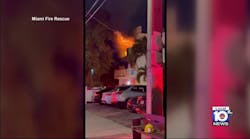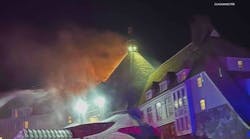Chief Jeff Bowman of San Diego Fire & Life Safety Services.Jeff Bowman was appointed as chief of San Diego Fire & Life Safety Services on May 6, 2002. Prior to his appointment, he was chief of the Anaheim Fire Department. Bowman joined the Anaheim Fire Department in 1973 as a firefighter. He graduated paramedic training in 1976 and was promoted to captain in 1979. In 1983, he was promoted to battalion chief, followed by a move to division chief two years later. He was appointed chief in 1986.Bowman has been president of the California Fire Chief's Association and the Orange County Fire Chief's Association. He is chairman of the Fire Apparatus Committee and the Ground Ladder Committee of the National Fire Protection Association (NFPA), and was the International Association of Fire Chiefs (IAFC) appointee to the Operation Life Safety Steering Committee. In Orange County, Bowman is or has been a board member of the Emergency Medical Care Committee, Paramedic Advisory Committee, Medical Quality Assurance Board, and Hazardous Materials Joint Powers Authority.
Governor Pete Wilson appointed Bowman to the State Board of Fire Services in 1997. He also was named 1993 Fireman of the Year by the Anaheim Firefighters Association. Orange County Fire Services presented him with both the Overachiever Award and the Monsignor Sammon Award for outstanding community service, and in 1987, he received the Distinguished Service Award from Sertoma. He has served as a board member of Anaheim Memorial Medical Center, where he also served a term as chairman. In 1998, the Cypress College Foundation Board selected him "Citizen of the Year" for Anaheim. Bowman also was recognized in August 1998 as one of the first six California fire chiefs to receive the distinction and recognition by the governor as a "certified fire chief" in the State of California. San Diego Fire & Life Safety Services provides fire protection and emergency medical services to the city's 1.3 million residents, as well as lifeguard protection at San Diego beaches. The department operates from 43 fire stations and 11 permanent lifeguard stations (plus 25 seasonal lifeguard stations), with 1,040 uniformed personnel and 166 civilian employees. Throughout his career, Bowman has involved his fire department staff in the community by sponsoring activities for young and old, including an immunization clinic, a holiday party with Santa, a haunted house and a Learn Not to Burn program. Youth has been the primary focus of his volunteer hours. A founding member, he was president of the Boys and Girls Club of Anaheim Board of Directors from 1988 to 1994 and was fundraising chairman for the Orange County Boy Scouts and Leukemia Society of Orange County. Bowman was interviewed by Editor-in-Chief Harvey Eisner.
Firehouse: Please describe your specific future plans for the department.
Bowman: The first initiative I set out to complete was a review of the organization from head to toe in hopes of creating a restructured organization that worked a little better for my style of management.
In that reorganization, I found several things that were needed. For one, our training division was severely understaffed. We have a fairly large training facility, which was one of the reasons one of the other key issues on my agenda for this first year was to put together a long-term plan for the training facility and the training division itself.
In the approved reorganization plan, we've doubled the number of people in training. A long-term plan will be to establish a highly successful regional training center that can attract fire training participants from a wide region of the United States.
The other thing that I've identified is the need for this organization to develop some long-term planning, i.e., a strategic plan and go through accreditation. Accreditation is not an easy task for any department, but for one this size, it's going to be a significant effort from a staffing standpoint, especially since it needs to be done along with strategic planning. But they do go hand in glove, and it's something that's sorely needed in San Diego.
Firehouse: Are you facing the same types of budgeting challenges as many other major fire departments?
Bowman: Probably my biggest surprise coming here is how severe the budget problems are - not just the day-to-day operational problems, but deferred maintenance on apparatus and fire stations, deferral of equipment purchases. All have created an environment in which it's difficult to improve the service here in San Diego. We're going to be lucky to maintain what we have. And I don't think that's unique to San Diego or California. I think it's a national problem.
Firehouse: Does your apparatus fleet need attention?
Bowman: The city actually started to do a four-year, multi-unit replacement plan, but they only got through a year and a half of that plan and then stopped funding it. There are many apparatus in this city that date back to the early 1980s, so it's a significant issue. I'm going to try to put together a fairly unique plan on how to deal with this one.
Firehouse: There seems to be a tremendous amount of construction taking place downtown. Is there as much building going on throughout the rest of the city?
Bowman: Yes, there's a great deal of building. Much has sprung from the decision to put the ballpark downtown. If you look in the outskirts of the city and even the projects throughout older neighborhoods in San Diego, building permits are being taken out in record numbers. The northern boundary of San Diego has been fairly rural, but now it's all being built with the big, custom homes, so new construction projects are pretty much citywide.
Firehouse: A lot of high-rises are being built. Are they all sprinklered? Are sprinklers required?
Bowman: All sprinklered, yes.
Firehouse: Is there a section of the city that still has not been utilized for building?
Bowman: The biggest area of development that will still occur is in the northern part of the city - up in the border areas of Rancho Sante Fe. One station will be completed at the end of this year, and we're trying to expedite the construction of two additional facilities planned for future years.
Firehouse: Are wildland issues still a major concern?
Bowman: A tremendous concern. As much as we have wildland areas abutting the city, we have another 200 linear miles of hillsides with houses on them in the city of San Diego city limits, so we have a huge problem.
This county is the only county that I know of in the state of California that doesn't have dedicated firefighting aircraft, so I'm trying to get the corporate community to help us generate funding to buy a helicopter so we can serve that need in the community and throughout the county.
Firehouse: You have talked about interagency training. Does that include responding to hazmat emergencies and weapons of mass destruction?
Bowman: It's always a big concern for all of us in fire services. The San Diego city fire department provides hazardous material service for the entire county through a joint powers authority, so that area is covered. I know there's talk right now of an additional unit in the northern part of the county because they're concerned, and rightfully so, with response time. But we do have our unit in northern San Diego, so it can respond to the northern part of the county fairly easily.
Firehouse: Do you plan to bring back the "train the trainer" program?
Bowman: Definitely, because as I mentioned, with our budget problems, we just don't have the money to send many people to classes, so our goal is to send out people who will come back and teach the classes.
Firehouse: You have a large contingent of female firefighters in the department that continues to grow.
Bowman: As you know, this is a service-wide issue. In fact, I spoke to a young lady on the phone today about becoming a firefighter. The goal is to try and get into the athletic programs in the junior college and the university levels to attract some of the more athletic females, the ones that we believe have the physical endurance to do the job.
We have a partnership with an ambulance corporation, Rural Metro, wherein we have a program that's designed to enhance diversity in the organization. We bring them in that way in hopes of eventually teaching them how to be firefighters.
Firehouse: Your staffing is four firefighters on an engine and four on a truck?
Bowman: During my interview to come down here, that subject came up and they wanted to know where I stood. I said I spent almost 29 years in Anaheim and I was a staunch supporter for four people on apparatus there. I will do the same here. I told them in the interview process that if you're looking for someone to come in and cut staffing, don't hire me, because I'm not your guy. They've had four here and I plan to keep it that way.
Firehouse: About civilianizing dispatch and repair facilities and some other activities, is that another plan because of the budget?
Bowman: Not really. When I did the organizational review, I discovered that what happens in a lot of fire agencies is they take safety people and do rotational assignments. It's designed I think with good intent to train people how to prepare themselves to be fire chiefs and understand different facets of the operation. But what I find is they transfer safety people into those highly technical positions, they stay two years, which is about how long it takes them to understand what they're supposed to do, and then they move them somewhere else and they start all over again.
I believe that not only is it more cost effective to have civilians filling some of these key positions, but you get organizational history and longevity of service. You actually get someone in who, for example, is a professional fleet manager, someone who knows how to run a large, modern emergency fleet. That individual can put a vision together and stick to it instead of changing course every two years. It really wasn't a budget idea or concept, but it turned out to be one.
Firehouse: Many departments across the country are having a lot of retirements. Is that affecting this department?
Bowman: It is, and I don't know about the rest of the nation, but California has a retirement benefit that has been enhanced in the last five years, and what we're seeing is mass exodus of many of our senior leaders. As a part of the reorganizational plan I mentioned earlier, that's a component of mentoring, and I've assigned somebody in the new organization to be responsible specifically for that, so that's something that we have to do. It's not something we would like to do: it's a must.
Firehouse: You talked about the need for five additional stations for the northern part of the city. Are there any other potential additions anywhere else?
Bowman: The five stations are actually citywide. Three of those will be in the north, specifically. I really believe that San Diego currently is understaffed in comparison to other metro departments in the United States. The accreditation and strategic planning processes hopefully will identify that, because I think there are other areas that need bolstering in the way of either fire stations or more units in existing stations. The other two are planned in the inner-city areas where response-time goals cannot be met.
Firehouse: I see that the fire department provides lifeguard services at the city's beaches. Is that a unique situation?
Bowman: Many West Coast fire departments are responsible for lifeguards; I think there's a perception that the lifeguards are not firefighters, so they're not as important. Before I got on the fire department, I worked for the city of Huntington Beach for the Harbors and Beaches Department (which was lifeguards), so I'm familiar with the history of lifeguards and I know what they're like.
When I came here, I told them I was interested in eliminating the barriers that exist to make them feel like equals. I've done probably as much in the lifeguard division as I have in the fire department since I've been here and plan to include them in all of our strategic planning processes and everything else to make them really feel part of the organization.
Firehouse: How many people are in the lifeguard division?
Bowman: They have 95 full-time employees and during the summer and the spring, when we start getting the warm weather, they'll have another 35 part-time employees, so it's a pretty big group.
Firehouse: Are there other projects or other things you would like to see for the city?
Bowman: One thing that I want to do is to see to it that San Diego doesn't have to go outside the department for a chief next time. It always amazes me when fire chiefs leave an organization and don't leave it such that the city manager or whoever does the hiring has a variety of people to pick from. I think we as a fire service are doing a disservice to ourselves when we don't plan ahead.
I want to do that at all levels, though. I think our deputies should be looking at battalion chiefs to mentor, and battalion chiefs should be looking at captains. If it doesn't start at the top, it won't happen at the bottom. I think that's one of the key things that I would like to do.
The other is to do benchmarking, because San Diego needs to know how it stands up with the rest of the fire service world. Unless you get outside of the city, outside of the state, go back to the East Coast and go to the Midwest and look around, you'll never know. They haven't don't much of that here, so I'm going to encourage benchmarking, just to find out how we stack up with others.
Firehouse: Outside of the fire department, how do you involve yourself in the fire service and in the community?
Bowman: I chaired the NFPA Apparatus Committee. I just finished my tours as chairman of Ground Ladders. I've been the board chairman of Community Hospitals. I've been the president of the Boys and Girls Club. I just believe in being active in the community and I will continue to do that here in San Diego. It's important to be a part of the community. When I have community issues like the helicopter, if I don't know who the business people are and I go out and ask for money, that the first thing I do is to meet them and ask for money or support, it doesn't work. You have to already have that relationship.






